 |
The Arabian Nights Wafa’ Tarnowska Shahriyar has found his wife and queen to be unfaithful. Hurt and full of anger, yet yearning for the comfort of a new woman, he declares he will marry a new woman each day. As the powerful shahanshah (or simply, shah) of Ctesiphon, he resolves to enjoy marriage, yet only briefly, spending one night with his bride and then condemning her to death the following day. Determined to break the shah’s vicious cycle, Shahrazade marries Shahriyar with complete confidence in her skill as a storyteller. Following their wedding, Shahrazade wastes little time is settling in for their first night together and telling him a story to distract him from her inevitable demise. The setting of these classic tales is unchanged by Tarnowska, but her unique compilation is accessible to both children and adults. The words of each story read as if Shahrazade is sitting beside the reader and each page is carefully designed to incorporate just enough illustration to create an image in the mind of the reader. Children will find many connections to the stories that surround them everyday, realizing their roots in the history of the Persian, Indian, and Arab world. Adults will be transported to a time of simple story telling, with just enough detail and action to allow readers to imagine themselves in the story, and not just lagging behind. A beautifully painted hardcover and cloth binding make this a magical collection that finds a natural place on bookshelves in homes, libraries, and classrooms. 2010, Barefoot Books, Ages 3 to 14, $24.99. REVIEWER: Patrice Russo Belotte (Children’s Literature). ISBN: 9781846861222 |
|
The Beast Within: A Tale of Beauty’s Prince Serena Valentino What led to the Beast’s curse? Using the classic Disney movie as her starting point, Valentino gives us her interpretation of what led to his unhappy plight. Friendly and compassionate as a child, Prince becomes increasingly vain and arrogant, even with his longtime friend Gaston, as he moves into his teen years. When Gaston determines Prince’s fiancée Circe is a pig farmer’s daughter, Prince angrily and cruelly discards her-and that leads to the curse. Circe is actually the younger sister of the three witches and, with their goading, sets a curse upon him so all will see him as the beast he is. Only finding true love by his twenty-first birthday will save him. The reader is witness to Prince’s physical and emotional transformation to Beast through his words and actions. As the years pass, Beast occasionally struggles to control his powerful rages, clings to his affection for some of the servants, searches for love, and grows repulsed by whom he has become, making him at times a sympathetic hero. The three witches, determined to cause his total demise, use magic to move him along that path. Told as a flashback, Belle is already imprisoned in his home as the story begins, but only briefly becomes part of Beast’s story as he nears his twenty-first birthday. Valentino’s writing is subject to simple and awkward phrasing as well as occasional jarring use of contemporary terms like “Okay.” She also interjects feminist thoughts on her female characters out of the blue. The book has a strikingly ominous cover and is a quick read, picking up pace as the witches become more involved in the story. While not great literature, this should be popular with tweens and young teens, not quite ready for more complicated fractured fairy tales. 2014, Disney Press, Ages 10 to 14, $16.99. REVIEWER: Peg Glisson ISBN: 9781423159124 |
|
 |
Breadcrumbs Anne Ursu Drawings by Erin McGuire A novel inspired in part by The Snow Queen inhabits two wintry worlds: one realistic, the other enchanted. Being brown-skinned and adopted wouldn’t be such a problem for Hazel if it didn’t underscore the bigger way she’s different: her personality and interests aren’t in synch with most other kids. The bright spot since she had to change schools following her dad’s departure has been her continuing friendship with Jack, who manages to be loyal to Hazel the two share a vivid imagination and love of adventure while maintaining other friendships. Still, a potential new friendship for Hazel leaves her feeling guilty about Jack, whose life is shadowed by his seriously depressed mother. But Jack’s dismissive behavior after Hazel hits him with a snowball is so extraordinary that Hazel is sure there’s something seriously wrong. And she’s right: a small piece of glass embedded in the snowball cut Jack’s eye. It came from the Snow Queen’s mirror and it’s turning Jack’s heart to ice. He becomes an easy target when the Snow Queen lures him away, and Hazel enters the woods where Jack was last seen, crossing a veil into a dark, fairy-tale world to find him. Hazel encounters archetypal characters from the world of folklore as she seeks out the Snow Queen’s lair, but whom can she trust? There are surprises at every turn in Anne Ursu’s deft, immensely satisfying blend of contemporary realistic fiction and fantasy that affirms the powerful bond of friendship. 2011, Walden Pond Press/HarperCollins, Ages 9-12, $16.99. REVIEWER: CCBC (Cooperative Children’s Book Center Choices, 2012). ISBN: 9780062015051 |
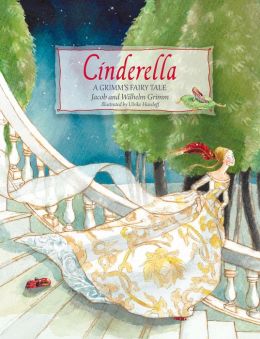 |
Cinderella Jacob and Wilhelm Grimm Illustrated by Ulrike Haseloff This retelling of the original Cinderella tale returns to a closer version of the Grimm version. Cinderella faces the same obstacles-death of her mother, remarriage for her father, servitude to the haughty stepsisters. However, without a fairy godmother, Cinderella resolves some of her own problems through her courtesy to the birds and her nurturing of a tree. The birds fulfill her stepmother’s demands to pick the lentils out of the ash, while the tree clothes Cinderella in a sparkling gold and silver ball gown and silk slippers. When the Prince seeks his beloved whose foot will slip into the abandoned silk slipper, one stepdaughter makes the gruesome decision to cut off her heel in order to squeeze her foot into the shoe. Fortunately, Cinderella’s tree warns the Prince of the stepsister’s deception, and the Prince returns to discover Cinderella, his true love and the perfect fit to the slipper. Without the cotton candy overtones of Disney, this Cinderella tale will both satisfy young readers and teach them a bit about character. 2013, Floris Books, Ages 4 to 8, $17.95. REVIEWER: Elisabeth Greenberg (Children’s Literature). ISBN: 978-0863159480 |
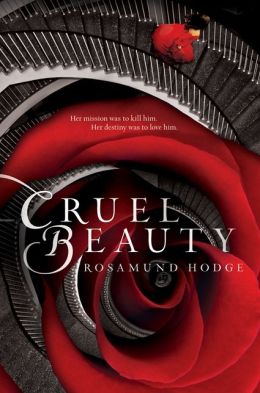 |
Cruel Beauty Rosamund Hodge Twin sisters, Nyx and Astraia live in the kingdom of Arcadia, an island ruled by the Gentle Lord, a demon. Before their birth, desperately wishing to give his wife the children she wanted, their father makes a deal with the demon lord. In exchange for the mother conceiving two daughters, one daughter must become the demon’s wife. But, as the kingdom knows the Gentle Lord never plays fair and the wife dies after Astraia is delivered with difficulty. Wish granted the bereft father is left to raise his daughters, and select which one is to be sacrificed. While Astraia is coddled and loved, Nyx is treated with cold detachment by her father-who decides to raise her with the sole purpose of defeating the evil beast to save the kingdom and its people. Now, upon her seventeenth birthday, Nyx must meet her destiny and marry Ignifex. Though resentful and bitter, Nyx has always pretended to be good and happy for the sake of her sister. She dislikes that her heart is secretly full of hate. The truth Nyx discovers in her husband’s castle, and how she comes to save the kingdom despite her love for Ignifex and his shadow slave, Shade, will surprise and thrill readers. This adaption of Beauty and the Beast combines Greek mythology, particularly the myth of “Cupid and Psyche,” with fairy tale lore to weave together a complex fantasy that is rich in detail, action, and hidden meanings. Nyx comes to embrace the darkness and the light that is within her and those she loves. Though some layers of the story unravel rather confusingly, this is a clever debut novel that delivers plenty of intrigue and romance. 2014, Balzer + Bray/HarperCollins, Ages 13 up, $17.99. REVIEWER: Emily Griffin (Children’s Literature). ISBN: 9781404881006 |
 |
Liesl & Po Lauren Oliver Illustrated by Kei Aceder The sun has not shined for 1,728 days and counting in YA author Oliver’s (Delirium) first book for middle-grade readers, a gloominess that underscores a plot in which adults seek personal gain at the expense of children. Classic fairy tale elements weave throughout this spirited, old-fashioned adventure: a young girl locked in an attic, a wicked stepmother, an alchemist, an orphan boy running from a cruel master. Add two nearly identical boxes-one containing the ashes of 11-year-old Liesl’s recently deceased father, the other holding “the Most Powerful Magic in the World”-and mix them up, and excitement begins to break through the bleakness. Po, a presence from “the Other Side,” brings Liesl a message to bury her father’s ashes underneath a certain willow tree, inspiring her to escape her imprisonment in her stepmother’s attic and head for the train. An exhilarating chase ensues, as characters pursue the runaway children and the mixed-up boxes. Invigorating and hopeful, this novel testifies to the power of friendship and generosity to conquer greed and depression. Final art not seen by PW. 2011, Harper/HarperCollins, Ages 8-12, $16.99. REVIEWER: Publishers Weekly (Publishers Weekly). ISBN: 9780062014511 |
 |
Mirror Mirror: A Book of Reversible Verse Marilyn Singer illustrated by Josaee Massee Singer has created a form of poetry called the reverso. Read traditionally down one side of a page, it tells one story. Read in reverse, with only punctuation and capitalization change allowed, it can tell a very different one, ” particularly for telling two sides of one story.” The topic here is fairy tales. The verse is free, the words chosen cleverly and carefully to evoke emotion in the telling. Some contrasting tales work better than others, but all are thought provoking as we admire the craft in the creation. Stories told in contrasting verses include “Cinderella,” “Sleeping Beauty” and her prince, “Rapunzel,” “The Frog Prince,” and “Beauty and the Beast,” among others. The split poem occupies one page. On the opposite page is a split picture with one major character opposing another, each in a setting with appropriate content. Characters and content painted in a flat decorative style tell the visual tales in ways that add romantic humor to the verses. Trying to write this kind of poem could be a real challenge to young readers. 2010, Dutton Children’s Books/Penguin Young Readers Group, Ages 7 to 12, $16.99. REVIEWERS: Ken and Sylvia Marantz (Children’s Literature). ISBN: 9780525479017 |
 |
The Ogre of Oglefort Eva Ibbotson Illustrated by Lisa K. Weber At the annual Summer Meeting of Unusual Creatures, a ragtag band of heroes is formed when the Norns (the Fates) charge an old swamp Hag, an angry troll, a hapless wizard, and one nonmagical boy with the task of rescuing Princess Mirella from the evil Ogre of Oglefort. Unfortunately, the Norns don’t have the story right: the princess isn’t trapped by the Ogre but is rather stubbornly staying at his castle until he grants her wish of being a bird so she can escape an arranged marriage. The Ogre, a vegetarian who has been turning people into animals for years instead of eating them, has suffered a nervous breakdown and simply refuses Mirella’s request. To their credit, when the heroes show up to bravely complete their task only to be met with a sniveling ogre and a spoiled princess, the group takes matters into their own hands, tending to the Ogre, convincing Mirella that life as a bird may not be the answer, and turning the Ogre’s neglected land into a veritable Garden of Eden. Alas, reality soon finds its way in, and the heroes must defend their paradise from attacks by goons sent by both the Norns and Mirella’s royal intended. Magical creatures abound in this effervescent fairy tale that effectively merges classic tropes with modern sensibilities. The late author’s knack for vivid language and colorful imagery completes the picture, while messages about respect for both oneself and one’s environment are subtly integrated without feeling forced. Fans of Ella Enchanted (BCCB 5/97) and the like will relish this straightforward tale of good, bad, and happy endings. Final illustrations not seen. Review Code: R — Recommended. 2011, Dutton, Grades 4-6, $16.99. REVIEWER: Kate Quealy-Gainer (The Bulletin of the Center for Children’s Books.) ISBN: 9780525423829 |
 |
A Question of Magic E.D. Baker When Serafina receives a letter from her great-aunt Sylanna, whom she has never met, she has no idea just how much her life is about to change. Sylanna writes about an inheritance that she wants to leave Serafina that requires the girl to visit. Upon arrival at her great-aunt’s cottage, however, mysterious things begin to happen: An ancient book with blank pages begins to write to her, skulls talk and move, and a cat seems to have answers to her questions. Slowly, Sarafina begins to realize that she has been summoned to take over the role of Baba Yaga, a mythical woman of fairy tales that many people have only half-believed in. Forced into this new role, Serafina has no way of getting in contact with her family or the boy she loves. In this enchanting retelling, E. D. Baker breathes new life into this traditional story. Young readers will delight in the bridge between the fairy tell elements, romance, and coming-of-age stories. This is a fast-paced and energetic tale that holds interest and has a neat and tidy satisfying conclusion. 2013, Bloomsbury Children’s Books, Ages 10 up, $16.99. REVIEWER: Jeanna Sciarrotta (Children’s Literature). ISBN: 9781599908557 |
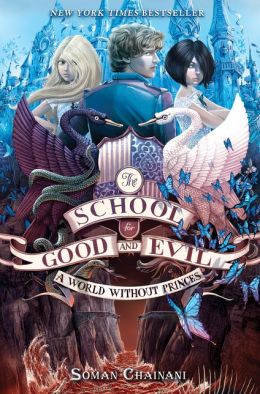 |
The School for Good and Evil Soman Chainani Illustrations by Iacopo Bruno Most girls do not expect to be kidnapped, much less anticipate it. But Sophie is not like most girls, and she has been planning for this day for some time. Every four years, two children disappear from her village of Gavaldon. Later, the children can be seen in the pages of the fairy tale books that mysteriously appear on the doorstep of the bookseller-one as a good character and one as a bad. Sophie is determined to go whether those children go and to claim “her” rightful place as a fairy tale princess. After all, Sophie is the prettiest and best person she knows. The role of “evil,” she believes, can be filled by her peer, Agatha. Growing up ugly in a cemetery practically assures it. The kidnapping, however, does not go as Sophie expects. She finds herself in the “Evil” school, while Agatha ends up in “Good”! Has the world gone mad? What is the mysterious Story Master thinking? Who is he, and what is his ultimate goal in all of this? Most importantly, will Sophie be able to win the handsome Prince Tedros (son of King Arthur) in spite of their different schools, and secure her fairy tale “happily ever after”? What will it mean if either girl fails in the school to which she has been assigned? Will Agatha find a way for them to return home? Word on the street is that the only way “out” of school is through the story, and animosity is brewing between the schools. Will they even survive? Stories based on fairy tales have experienced a revival, but Chainani is a unique spin on the idea. The setting is completely new, the challenges dire, and the characters well-developed. It is no wonder this book has been a New York Times bestseller. This is the first book in a trilogy. Do not miss the “Are You an Ever or a Never” quiz on the publisher’s website. 2013, Harper/HarperCollins Publishers, Ages 10 up, $16.99. REVIEWER: Heidi Hauser Green (Children’s Literature). ISBN: 9780062104892 |
 |
Seal Song Andrea Spalding Illustrated by Pascal Milelli Drawing on the Celtic legends of the selkies–seals that take on human form–comes this haunting original story set near a salmon cannery on the Canadian seacoast. Young Finn loves to swim among the seals and he longs for the day when one will call to him. He rescues a seal from a net and cares for the animal until it is well. When a young mysterious girl, named Sheila, appears in town Finn is convinced she is his seal. Just like the selkies of lore, she does not go near the sea for legend has it that if salt water touches a selkie it will revert to its seal form. While Sheila lives among them, the fishermen have a successful harvest of salmon but none is as great as Finn’s father’s haul. One day in fall, Finn decides to sail out for one more catch, heedless of Sheila’s warning. When a storm arises, he hears her plaintive cry to turn back. Sheila dives deep into the sea where her call is heard by other seals that join her in a frantic race to save Finn. In the morning Finn is found washed up on the shore asleep with a seal skin protectively covering him. Sheila is never seen again. This beautiful, lyrical tale is a perfect one to introduce young readers to the lore and the magic of the selkies. Care is given to the language of the narrative and the poetry of the songs. The seal swims “riding wave crests, / exploring hidden depths, /laughing, splashing, celebrating”. In the storm, “Wind hammered. /The boat heeled. /Finn staggered.” Combine roughhewn oil paintings with hues of greens and blues with the lilting language and you have a magical tale of love and friendship. 2011, Orca Book Publishing, Ages 7 to 10, $19.95. REVIEWER: Beverley Fahey (Children’s Literature). ISBN: 9781554692422 |
 |
Shadows on the Moon Zoe Marriott Johanna Nation-Vallee (VOYA, December 2012 (Vol. 35, No. 5)) A magical rendering of feudal Japan provides inspiration for the Moonlit Land, backdrop for Marriott’s latest novel, a retelling of the Cinderella story featuring sixteen-year-old Suzume Hoshima. Suzume possesses the rare and powerful gift of shadow-weaving that allows her to create illusions or conceal herself at will. After witnessing the murders of her father and cousin, Suzume must develop her talent to survive and exact revenge on her enemies, who are closer than she realizes. When she falls for the exotic Otieno, whose magical abilities match her own, she must decide whether to relieve her suffering through manipulation and murder or through acceptance and love. Divided into three sections, Shadows on the Moon highlights Suzume’s evolving identities throughout the story, from noble young girl to drudge in her stepfather’s kitchen to her final incarnation as a celebrated courtesan angling for the Moon Prince’s hand. The pace is slow due to rich descriptions and multiple layers of storytelling. The result, while beautiful, emphasizes the fairy tale romance over the perhaps more original and compelling story of Suzume’s emerging magical abilities. Suzume’s darker emotions and impulses may disturb some readers, as may descriptions of self-harm. Fans of fantasy in general and fairytales in particular should thoroughly enjoy this book, though it will undoubtedly attract more female readers. Violence and minor sexual content make this novel more suitable for older teens. VOYA CODES: 4Q 4P S (Better than most, marred only by occasional lapses; Broad general YA appeal; Senior High, defined as grades 10 to 12). 2012, Candlewick, 464p., $17.99. Ages 15 to 18. ISBN: 9780763653446 |
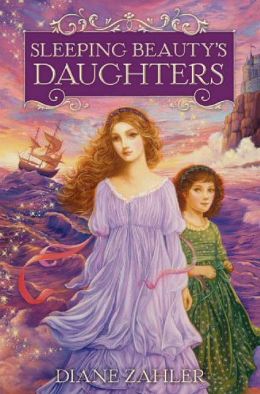 |
Sleeping Beauty’s Daughters Diane Zahler Princess Aurora lived under a curse without knowing it until too late, thanks to her little sister’s wildness and her parents’ overprotectiveness. Just like Sleeping Beauty (a.k.a. her mother), Aurora can hardly stay awake. Luna, her enterprising young sister, convinces Aurora that the only way to defeat the curse is to go in search of the good fairy godmother, Emmeline. Off they go, with Luna pinching Aurora’s arm and Aurora drinking energizing herbal tea at every droopy an eyelid. Unfortunately, the wicked fairy godmother known as Manon not only engineered the entry of the sharp instrument into the castle for the curse, but also has her evil eye on Aurora. Facing dangers from uncanny storm winds to mythical beasts and quicksand, the intrepid sisters finally dodge through a whirlpool before being brought by their uncle Leander and their staunch sailor boy companion to Emmeline’s fantastic island. In a face-off with Manon, Luna has one final brilliant idea for Emmeline, and Aurora is delivered. The wicked Manon, furious at being tricked and abandoned by her obsession, Uncle Leander, self-combusts! Aurora and Luna turn the concept of “princess” on its head by discovering their own courage and brilliance and compassion in this story. Rich with humor and detail, this book should be sought out by librarians and grandparents for middle school readers who loved fairytales and are in search of books with strong characters. 2013, Harper/HarperCollins, Ages 10 to 14, $16.99. REVIEWER: Elisabeth Greenberg (Children’s Literature). ISBN: 9780062004963 |
 |
Snow White and the Enormous Turnip Hilary Robinson Illustrated by Simona Sanfilippo Most of us probably know the traditional story of Snow White and the seven dwarfs, especially with the success of the Disney movie. In this variation two stories have been combined; that of Snow White and that of the Enormous Turnip. It begins in the traditional manner with Snow White in the castle with her stepmother the Queen who has a magic mirror and frequently asks who the fairest maid of all is. When the mirror tells her that Snow White is much prettier, the Queen becomes very angry and tells the woodcutter to take Snow White out into the woods to let her die. But the woodcutter was kindhearted and he left her at the door of seven dwarves who took her in. Snow White planted seeds and worked in her garden every day. One turnip grew so large that she could not pull it out of the ground. In the meantime, the Queen learned that Snow White was still alive, so she disguised herself and went into the woods. She gave Snow White a poisoned apple tart, but the evil Queen was foiled when a handsome prince came riding along and kissed Snow White and helped her pull the turnip of out of the ground. In the end the married couple and the dwarves all celebrated with a turnip pie. The illustrations which clearly tell the story are done in a cartoon rather than realistic style. The closing page contains notes for adults as well as suggestions for activities before and after reading the book. “Tadpole Fairytales Jumbles” are designed for transitional and early fluent readers. They are dependent on the reader’s knowledge of the original rhymes so they can appreciate the unique twist on the traditional tales. This is a Guided Reading Level E text. 2012 (orig. 2008), Crabtree, Ages 4 to 6, $7.95. ISBN: 9780778780359 |
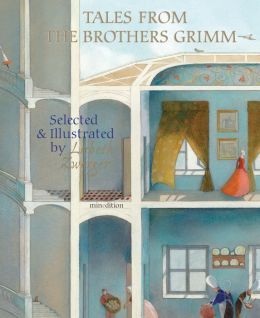 |
Tales from the Brothers Grimm Selected and Illustrated by Lisbeth Swerger If there is one reason to select this collection of Grimm tales it is Lisbeth Zwerger’s name on the cover. The tales that have been selected include the familiar, (“Hansel and Gretel,” “The Bremen Town Musicians” and “The Brave Little Tailor”) as well as the lesser known “Hans My Hedgehog” and “The Poor Miller’s Boy and the Little Cat”). The lyrical retellings paint pictures with words and the addition of Zwerger’s distinctive artwork further enhances the telling. A small sepia drawing introduces each tale, and the full-color paintings that follow draw the readers into the story. There is a haunting quality to the paintings; the focus is on the eyes that often are looking back or off into the distance with a wistful longing. Elegant in its design and refreshing it its retellings, this is a “must” for anyone seeking a distinctive collection of Grimm stories. 2013, minedition/Michael Neugebauer Publishing Ltd, Ages 5 to 12, $29.99. RREVIEWER: Beverley Fahey (Children’s Literature). ISBN: 978988-8240531 |
 |
Truly, We Both Loved Beauty Dearly!: The Story of Sleeping Beauty as Told by the Good and Bad Fairies Trisha Speed Shaskan Illustrated by Amir Tayal. This entry in “The Other Side of the Story” series alternates the voices of the Good and the Bad Fairy as they explain the real mixed-up story of Sleeping Beauty. Edna claims that BF did not stand for Bad Fairy originally, but rather Best Fairy, a title given her by the king. Unfortunately, Edna began to forget things and mix-up words, finally saying “die” instead of “cry” at Sleeping Beauty’s christening. Her younger sister Stella, the Good Fairy, quickly tried to fix things by substituting a hundred year sleep for death. Good-hearted Edna tries to fix things herself on Sleeping Beauty’s 16th birthday, but once again her plans go awry. Again, Stella fixes things as well as she can, this time shedding sleep on all in the castle. Both fairy sisters are there at the wake-up kiss, to wish well on all. This amusing retelling of the Sleeping Beauty story lends itself to reading-aloud in two voices, either by the teacher or by students. The core curriculum questions included at the end are more suitable for older children, although the third question about what blunders Edna makes and how they are fixed could be discussed easily with younger children on a third or fourth reading. 2013, Picture Window Books/Capstone, Ages 4 to 8, $26.65. REVIEWER: Elisabeth Greenberg (Children’s Literature). ISBN: 9781479519453 |
Fairy Tales
 |
And they all lived “Happily Ever After.” Or sometimes not! February is a great month to enjoy these traditional and fractured fairy tales.
Web links to additional information and activities about Fairy Tales follow these reviews. Contributor: Peg Glisson |
Reviews
|



